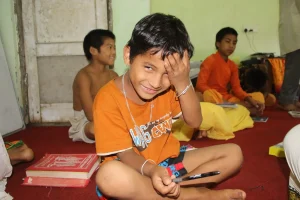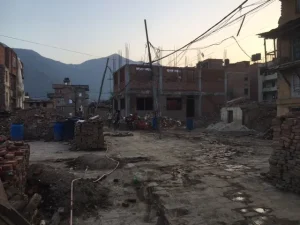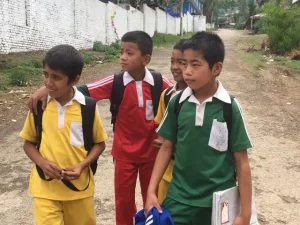How did the project start?
Often, when we think of Pashupatinath, our minds instinctively capture images of the majestic main temple, which in and of itself is the epitome of devotion and reverence. Yet, beneath the shadow of its towering presence, lie numerous other temples, each with its own glory and story to tell. It is regrettable that many pilgrims and tourists, including local visitors alike, remain unaware of the existence of these smaller, yet equally significant, structures/sites that shape the landscape of this sacred space. Amidst the socio-political turmoil and lack of proper education about our heritage, the knowledge of these places has not been properly transmitted to the younger generation. We expected to find an abundance of resources to delve deeper into its myths, legends, and historical significance. However, to our disappointment, we discovered a lack of accessible and relevant materials that could provide comprehensive knowledge about this remarkable place. The available resources were either dense and difficult to comprehend or provided only superficial information. Observing this scenario is what inspired the beginning of our project.
How did we create our team?
After feeling the need to create genuine, easily accessible, and easy-to-read material about Pashupatinath, one of the UNESCO World Heritage Sites, we started to expand our team through word of mouth. We didn’t do any interviews or application process. Somehow surprisingly, we ended up with 12 members each with a unique set of skills and strengths that came to be handy at one point or the other during the project.
How did we conduct our research?
We wanted the book to contain genuine information about the Pashupatinath Area but in a simple language and artistic format. We undertook two approaches that complemented each other. First, we conducted a series of field visits to Pashupatinath. Swami Kedarman Bhandari Ji, a renowned advocate of Pashupatinath Area conservation guided our team. He has directly served in the Pashupatinath Trust administration and has been one of the Bhandaris of Pashupatinath for several years. We obtained on-site information about Pashupatinath from him. Second, we used several books as our primary source of reference to double-check our field visit information. We would make note of things that were missing during the visits and then explore those places on our next visits.


How did we compile and what was our vision behind the ebook format?
We compiled all our collected information into an aesthetically appealing format. We wanted to put the information in a way that would serve as a guide for anyone who is visiting or reading about the Pashupatinath Area. The idea behind creating an ebook rather than publishing a hardcover book is to ensure that the material remains accessible to as many people as possible without any physical or economic barrier. One can simply download it for free on their phone or computer and read about Pashupatinath from anywhere in the world.

When Shiva was everywhere….
Since the beginning of the project, things have been happening randomly yet perfectly.
“ The very thought of doing this project occurred out of the blue when I was sitting silently after my morning meditation” — Laxman Bista
We started our site visits around Mahashivaratri. The book contains 9 sections which are equivalent to the 9–9 symmetry (more in the book) of the Pashupatinath area. The font size of our content was 13 which is the number associated with Shiva. The total number of members in our team was 13 as well. And finally, the book itself was launched on the auspicious occasion of Guru Poornima. What’s more, the Nepali version of the book was also launched on the last Monday of Sharawan month which is considered a favorite month of Shiva.
We felt as if the grace of Shiva was with us throughout the journey of this project. We didn’t expect we would accomplish this much in this short amount of time, but impressively it all happened.
The Virtual E-Book Launch Program
Perhaps, this event was one of the highlights of the project. We wanted to do something different that the usual book launch events. After the completion of our book, we organized a grand Virtual Book Launch Event with Adv. Sanjay Adhikari, Swami Kedarman Bhandari, and Jogi Debnath as our speakers. There were 100+ online participants and the livestream was watched by 1000+ audiences. The fun part of the program was when our website server crashed because a huge number of audiences were downloading the book at the same time. Overall, our Virtual Book launch event was the first of its kind and was a grand success. Our project was appreciated by all which inspired us even more. The link for the recording of the event can be accessed here.
A month after publishing the English version of the book, we also published the Nepali translation of the book. Now, our book is available in both languages. Our goal was to make the book accessible to people who can’t understand English. You can access the book here.
How did we introduce the “Save the Heritage” campaign to manifest our long-term vision of exploring and documenting the heritage of Nepal?
Recently, after receiving huge appreciation and encouragement from the audience and activists from the heritage conservation sector, our lead team members have decided to take our project to initiate a youth campaign called “Save the Heritage”. Save the Heritage is geared towards the conservation of the objects and sites of heritage in Nepal through exploration, documentation, and communication of the historical and cultural importance of those heritages. This is our long-term vision. Through active participation of youth and mentorship and guidance of the experts, we hope to create more similar ebooks for many other heritages of Nepal. The resources we create will be pivotal in spreading awareness and literacy about our heritage among people in Nepal as well as the Nepali diaspora abroad. Especially, the young generation that is growing up in the Nepali diaspora has even less exposure to our heritage compared to the young generation within Nepal. If we want to instill cultural values and national spirit in them, we need to support and invest in creating materials and resources like these.
What is there next year?
Next year we are planning to create an e-book documenting the Jatras in the Kathmandu Valley and other parts of Nepal. It is believed that there are 108 Jatras in total, however not all of them are in practice these days and many of them are on the verge of getting lost. Through this project, we plan to document as many Jatras as possible with as much detail as possible. If you want to support or be a part of the project, please contact our team at Save the Heritage. Our contact details are:
Facebook page: Save the Heritage
Email: [email protected]





